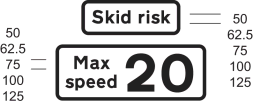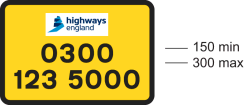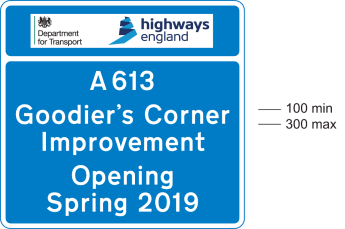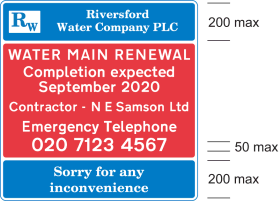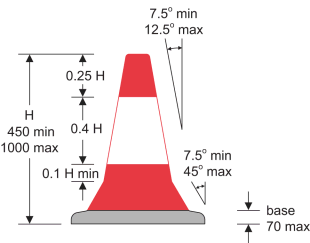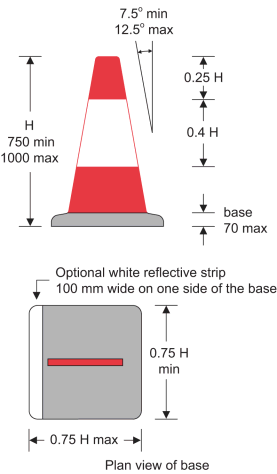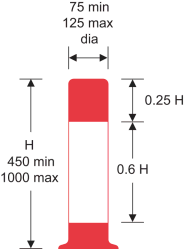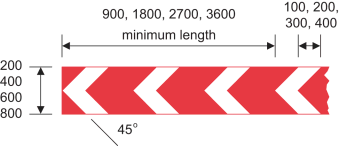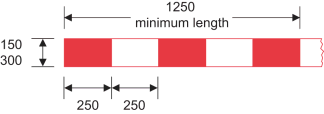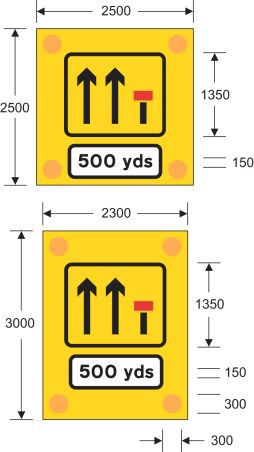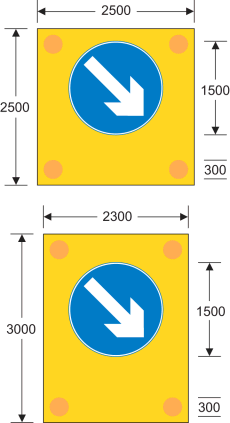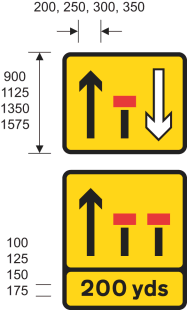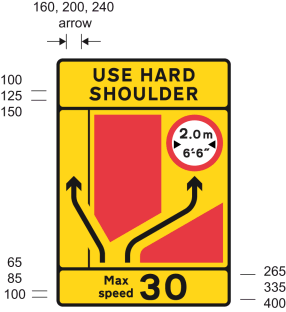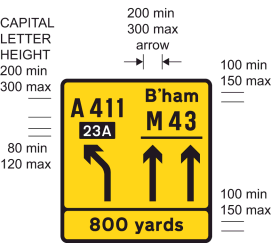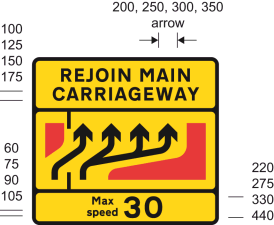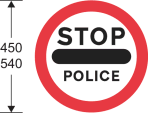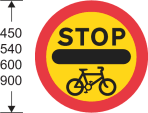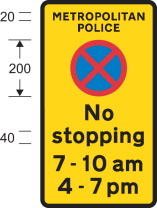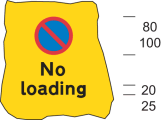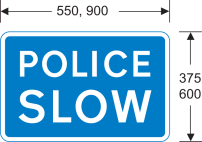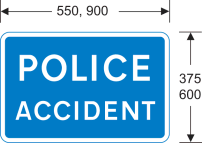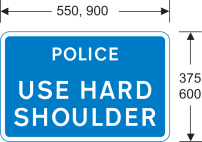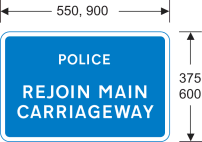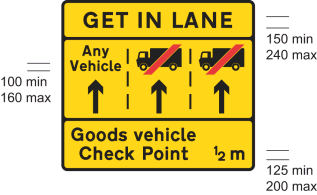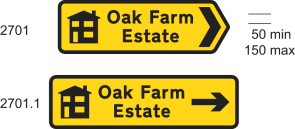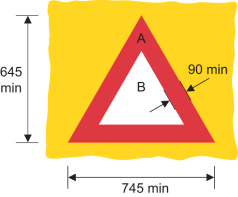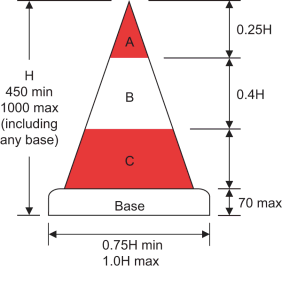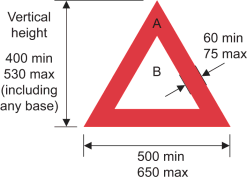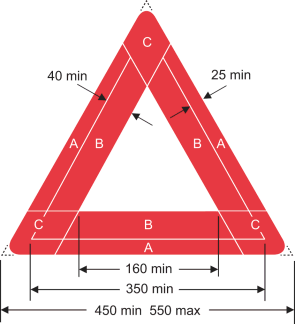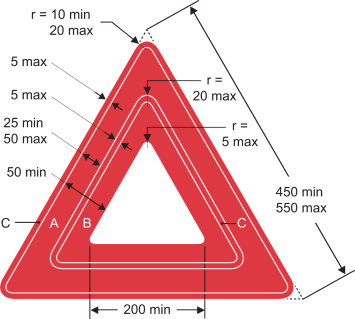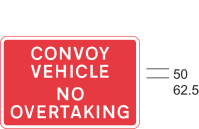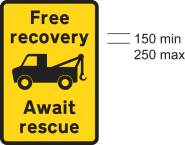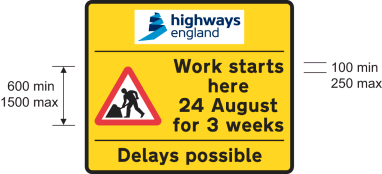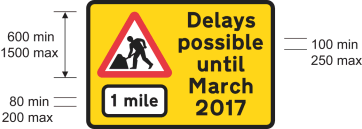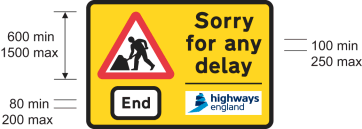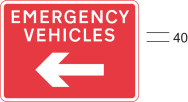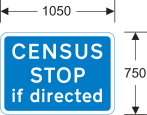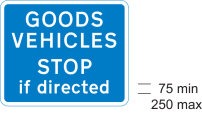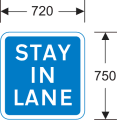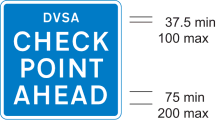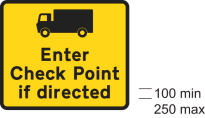Regulation 3, Direction 3
SCHEDULE 13Signs only for use in temporary situations
PART 1Provisions applying to signs in Part 2
1. A warning of a description in column 2 of an item in the sign table in Part 2 must be conveyed by a triangular sign that is of—
(a)the colour and type provided for in the diagram in column 3; and
(b)the size shown in the diagram above the table.
2. A plate containing a legend provided for in column 4 (“a first associated plate”) must—
(a)be of the colour and type; and
(b)comply with the requirements as to size,
provided for in the diagram above the table.
3. If there is a number in column 5, the equivalent item number in the table in Part 4 is a supplementary associated plate for the triangular sign in question.
4. The number in column 6 indicates that the equivalent numbered Schedule 13 General Direction applies to the triangular sign in question.
PART 2Signs for use in temporary situations
Sign table — Schedule 13, Part 2
(1) Item | (2) Description | (3) Diagram | (4) First associated plate legend | (5) Supplementary associated plate by reference to item number in the Part 4 sign table | (6) Schedule 13 General Directions |
|---|---|---|---|---|---|
| 1 | Diagram 551.1 Migratory toad crossing ahead | “For” and a distance | |||
| 2 | Diagram 554A Worded warning sign (Flood) | 1. A distance with or without an arrow pointing to the left or to the right; or 2. An arrow pointing to the left or to the right | |||
| 3 | Diagram 554D Worded warning sign (No Smoking) | 2. A distance with or without an arrow pointing to the left or to the right; or 2. An arrow pointing to the left or to the right | |||
| 4 | Diagram 554.2 Risk of ice or packed snow ahead | 1. “Ice”; 2. “Ice for” and a distance; 3. “Snowdrifts”; or 4. “Snowdrifts for” and a distance | 1 | ||
| 5 | Diagram 556 Uneven road ahead | “For” and a distance | 1 | ||
| 6 | Diagram 557 Slippery road ahead | “For” and a distance | |||
| 7 | Diagram 562 Other danger ahead | 1. A word or phrase at paragraph 4; 2. A word or phrase at paragraph 4 followed by a distance; or 3. The legend at 1 or 2 with an arrow pointing to the left or to the right; 4. The words and phrases are— (a) Accident; (b) Census; (c) Dust cloud; (d) Fallen tree; (e) Frost damage; (f) Overhead cable repairs; (g) Runners in road; (g) Smoke; (h) Walkers in road | 1, 2 or 3 | 1, 2 | |
| 8 | Diagram 950 Cycle race or test ahead (Alternative types) | 1. A phrase at paragraph 4; 2. A phrase at paragraph 4 followed by a distance; or 3. The legend at 1 or 2 with an arrow pointing to the left or to the right; 4. The phrases are— (a) Child cycle tests; (b) Child cycle tests; (c) Child cycle training; (d) Cycle event; | 1 | ||
| 9 | Diagram 7001 Road works or temporary obstruction of carriageway ahead | 1. A distance; 2. “For” and a distance; 3. A word or phrase at paragraph 8 (where “End” indicates the end of all restrictions or prohibitions associated with road works); 4. A word or phrase at paragraph 8 (other than “End”) followed by a distance; 5. An arrow pointing to the left or to the right on its own or with the legend at 1, 3 or 4; 6. “On” and a route number, with or without a direction of travel; or 7. A route number with or without a direction of travel; 8. The words and phrases are— (a) Line painting; (b) At level crossing; (c) Blasting; (d) Ditching; (e) Grass cutting; (f) Gritting; (g) Gully emptying; (h) Hedge cutting; (i) Lighting maintenance; (j) Mobile road works; (k) On hard shoulder; (l) On slip road; (m) Overhead works; (n) Road sweeping; (o) Salting; (p) Sign erection; (q) Sign maintenance; (r) Snow ploughing; (s) Surveying; (t) Tree cutting; (u) Weed spraying; (v) End | 4, 6(1) | ||
| 10 | Diagram 7009 Loose chippings on road ahead | 1. A distance; 2. “For” and a distance; or 3. An arrow pointing to the left or to the right on its own or with the legend at 1 or 2 | 2 or 3 | 3 |
PART 3Provisions applying to plates in Part 4
1. A warning of a description in column 2 of an item in the sign table in Part 4 must be conveyed by a plate that—
(a)is of the colour and type; and
(b)complies with the requirements as to size,
provided for in the diagram in column 3.
2. In relation to item 3, the warning is conveyed by both of the plates and paragraph 1 applies to each of those plates.
3. The plate provided for at item 2 may have a different numeral to that shown in the diagram.
PART 4Optional supplementary plates used only in combination with signs shown in Part 2
Sign table — Schedule 13, Part 4
PART 5Provisions applying to signs in Part 6
1. A warning, requirement, restriction or prohibition of a description in column 2 of an item in the sign table in Part 6 must be conveyed by a sign that is of the colour and type, and complies with the requirements as to size, provided for in the diagram in column 3, or that diagram as varied in accordance with column 4.
2. In respect of items 9 and 10, each lamp incorporated into the sign must show an intermittent amber light at a rate of flashing of not less than 60 nor more than 90 flashes per minute, and in such a manner that the lights of one horizontal pair are always shown when the lights of the other horizontal pair are not shown.
3. If a number appears in column 5, the equivalent paragraph number in Part 7 applies to the sign in question.
4. The provisions of Part 8 apply to cones (item 4), delineators (item 5) and cylinders (item 6).
5. A number in column 6 indicates that the equivalent numbered Schedule 13 General Direction applies to the sign in question.
6. Where provision is made in column 4 for a different logo to that shown in the diagram to be included, the logo may incorporate any image and lettering in any style and colour.
7. Where provision is made in column 4 for the name of an organisation to be used instead of a logo, that is a reference to the name being used other than as part of a logo and is not to be taken as preventing the name of the organisation from being incorporated into a logo.
PART 6Additional Temporary Signs
Sign table — Schedule 13, Part 6
(1) Item | (2) Description | (3) Sign diagram | (4) Permitted variants | (5) Applicable requirements in Part 7 | (6) Schedule 13 General Directions |
|---|---|---|---|---|---|
| 1 | Diagram 7006.1 Information on telephone number to be used for enquiries about road works | 1. The Highways England logo may be varied to another logo used by Highways England or replaced by “Highways England”; 2. The logo may be varied to “Scottish Government”, “Welsh Government” or a logo of the Scottish or Welsh Government; 3. The logo may be varied to the name or logo of that part of the Scottish or Welsh Government that is, by virtue of the organisation of the government, responsible for the maintenance or improvement of the road; 4. The logo may be varied to the name or logo of another traffic authority; 5. The telephone number may be varied | 9 | 4 | |
| 2 | Diagram 7007.1 Relevant particulars of major construction or improvement scheme being carried out on road ahead | 1. The Highways England logo may be varied to another logo used by Highways England or replaced by “Highways England”; 2. The Department for Transport logo may be varied to another logo used by the Department or replaced by “Department for Transport”; 3. The Department for Transport logo may be varied to the name or logo of another Department of Her Majesty’s Government; 3. Either or both logos may be omitted; 4. The Highways England or Department for Transport logo (or both) may be replaced by one or two of the following (provided that in total no more than two names or logos are shown)— (a) “Welsh Government” or a logo used by the Welsh Government; (b) “Scottish Government” or a logo used by the Scottish Government; (c) the name or logo of that part of the Scottish or Welsh Government that is, by virtue of the organisation of the government, responsible for the maintenance or improvement of the road; (d) the name or logo of another traffic authority; 5. The particulars of the construction or improvement scheme may be varied | 10 | 4 | |
| 3 | Diagram 7008 Nature of street works, giving names of undertaker and contractor, emergency telephone number, and apology for in-convenience (Sign for pedestrians) | 1. The name of the undertaker (and logo) and contractor, the nature of the works, the completion date and telephone number may be varied; 2. Each line of lettering may have a different x-height which must be smaller than the telephone number; 3. The description of the works, the completion date and the name of the contractor may be omitted; 4. The top and bottom panels may be in any colour and style of lettering; 5. A logo indicating membership of a national street works good practice scheme may be added to the top or bottom panel; 6. The bottom panel may be omitted; 7. The top panel may be omitted provided the undertaker’s name is shown on the red panel | 10 | 4 | |
| 4 | Diagram 7101.1 Edge of a route for vehicle traffic through or past a temporary obstruction (Traffic cone) | The colour of the base may be varied in accordance with Part 8, paragraph 2 | 12 | 4 | |
| 5 | Diagram 7102 Edge of a route for vehicular traffic through or past a temporary obstruction on a motorway or dual carriageway road (Flat traffic delineator) | The colour of the base may be varied in accordance with Part 8, paragraph 4 | 2, 12 | 4 | |
| 6 | Diagram 7103 Line of division of traffic flows on one carriageway, or to indicate the edge of a route for vehicular traffic through or past a temporary obstruction, or to mark a boundary between two carriageways of a dual carriageway road which may not be crossed except for fire and rescue authority, Scottish Fire and Rescue Service, ambulance or police purposes (Traffic cylinder) | ||||
| 7 | Diagram 7104 Sharp deviation of route at or near road works or other temporary obstructions | The sign may be reversed to show a deviation to the right | 4, 8 | ||
| 8 | Diagram 7105 Position of barrier to mark length of road closed to traffic or to guide traffic past an obstruction | 4, 8 | |||
| 9 | Diagram 7402 Lanes closed to traffic ahead by vehicles carrying out mobile road works (Alternative types) | 1. The number of arrows and symbols indicating the number of lanes and those which are open or closed to traffic may be varied; 2. “500 yds” may be varied to an alternative distance to the nearest 50 yards, to “Ahead” or, on the lower image, to “On slip road” on two lines; 3. The distance plate may be omitted | 9 | 4, 6(3) | |
| 10 | Diagram 7403 Other traffic to keep to the right of vehicles carrying out mobile road works (Alternative types) | The arrow may point downwards to the left | 1, 9 | 4, 6(3) | |
| 11 | Diagram 610 Sign— (a) attached to the front or back of a road maintenance vehicle to indicate the side on which traffic should pass; or (b) placed in relation to an emergency or breakdown vehicle which is temporarily obstructing the road to warn other traffic of the obstruction and to indicate the way past the vehicle | 1. Arrow may point downwards to the left; 2. When attached to a vehicle, the diameter of the sign may be reduced to 1200 or 900 mm where it is not practicable to mount the 1500 millimetre diameter sign on the vehicle; 3. When placed in relation to an emergency or breakdown vehicle, the diameter may be reduced to 1200 or 900 mm | 1, 11 | 6(1), 6(2) | |
| 12 | Diagram 7404 Nature of work being done by vehicle working on the highway (Sign attached to a road maintenance vehicle) | 1. “HIGHWAY” may be varied to “MOTORWAY” or “ROAD”; 2. The legend may be on one line | 9, 10 | 4, 6(3) | |
| 13 | Diagram 7202.1 Temporary lane availability (Alternative types) | 1. The number of arrows and symbols indicating the number of lanes and those which are open or closed to traffic may be varied; 2. Where the sign has a bottom panel, the legend may be varied to another distance or to “On slip road”, provided the legend appears on no more than three lines | 9 | 4 | |
| 14 | Diagram 7243 Temporary road layout with lane restrictions | 1. In the top panel the legend may be— (a) varied to “REJOIN MAIN CARRIAGEWAY” or “NARROW LANES”; (b) on one line; 2. The top panel may be omitted; 3. In the middle panel— (a) the arrows and symbols may be varied to indicate the layout of the traffic lanes provided that the shape of an arrow head is not varied; (b) an individual arrow may include more than one arrow head; (c) the numerals on the width limit symbol may be varied; (d) the width limit symbol may be omitted or varied to a symbol shown in column 3 of the sign table in Part 20 of Schedule 12 at items 24, 25, 28, 30, 33, and 35; (e) the size of a symbol referred to in paragraph (d) may be varied from that shown for the symbol in Part 20 of Schedule 12; (f) route numbers may be added with the x-height being 100, 125 or 150 mm; (g) the route numbers referred to in paragraph (f) may be followed by “only” at the same x-height; (h) a motorway junction number in white characters on a black patch may be added in a manner similar to the patch shown in the diagram at item 15, the x-height being 80, 100 or 120 mm; (i) a horizontal bar may be added in the manner shown in the diagram at item 15 where two or more lanes are associated with the same route number; (j) a white downward pointing arrow, as shown in the upper diagram at item 13, may be added to indicate a contraflow traffic lane 4. In the bottom panel— (a) the numerals indicating the maximum speed advised may be varied; (b) the legend may be varied to a distance with an x-height of 100 mm, 125 mm or 150 mm; (c) the distance referred to in paragraph (b) may be preceded by “For”; 5. The bottom panel may be omitted | 9 | 4, 5 | |
| 15 | Diagram 7244 Temporary road layout, with an indication of destinations and route numbers, where the sign is placed on a motorway | 1. A panel with the legend “USE HARD SHOULDER”, “REJOIN MAIN CARRIAGEWAY”, “NARROW LANES”, “EVENT TRAFFIC” or other appropriate legend, may be added above the top panel in a manner similar to the top panel shown in the diagram at item 14 with an x-height of not less than 100 mm, nor more than 150 mm; 2. In the top panel— (a) the arrows may be varied to indicate the layout of the traffic lanes provided the shape of an arrow head is not varied; (b) a white downward pointing arrow, as shown in the upper diagram at item 13, may be added to indicate a contraflow traffic lane; (c) the symbol indicating a closed lane, as shown in the diagrams at item 13, may be added; (d) where the sign is placed other than on a motorway, any route number must have characters of the form shown in Part 2 of Schedule 17 with an x- height of not less than 100 mm, nor more than 150 mm; (e) a symbol shown in a diagram in Part 11 or 20 of Schedule 12 may be added and the size of the symbol may be varied from that shown; (f) a destination or route number may be varied or omitted, and additional destinations and route numbers added; (g) the junction number may be varied or omitted; 3. In the bottom panel the distance may be varied; 4. The bottom panel may be omitted | 9 | 4, 5 | |
| 16 | Diagram 7245 Temporary road layout | 1. In the top panel the legend may be- (a) varied to “USE HARD SHOULDER” or “NARROW LANES”; (b) on one line; 2. The top panel may be omitted; 3. In the middle panel— (a) the arrows and symbols may be varied to indicate the layout of the traffic lanes provided the shape of an arrow head is not be varied; (b) an individual arrow may include more than one arrow head; (c) black symbols representing the division of traffic lanes may be added in a manner similar to that shown at item 14 of the sign table in Part 2 of Schedule 11 or at item 1 of the sign table in Part 28 of Schedule 12; (d) a white downward pointing arrow as shown in the upper diagram at item 13 may be added to indicate a contraflow traffic lane; (e) destinations and route numbers may be added with an x-height of 100, 125, 150 or 175 mm; (f) a junction number panel may be added in a manner similar to that shown in the diagram at item 15, the x-height being 80, 100, 120 or 140 mm; (g) symbols provided for in Parts 11, 12, 14, 15, 17 and 18 of Schedule 12 may be added; 4. In the bottom panel— (a) the numerals indicating the maximum speed advised may be varied; (b) the legend may be varied to a distance with an x-height of 100, 125, 150 or 175 mm; (c) the distance may be preceded by “For”; 5. The bottom panel may be omitted | 9 | 4, 5 | |
| 17 | Diagram 633 Vehicular traffic must not proceed beyond the sign where displayed by a constable in uniform or by a traffic warden | A red or transparent protective strip, with a visible width not exceeding 6 mm, may be applied to the perimeter of the sign | 10 | ||
| 18 | Diagram 633.1 Vehicular traffic must not proceed beyond the sign | A red or transparent protective strip, with a visible width not exceeding 6 mm, may be applied to the perimeter of the sign | 1, 9 | 9 | |
| 19 | Diagram 636 Temporary prohibition of waiting except for loading and unloading | 1. The name of the police force or traffic authority, or the word “Police” or “POLICE” may be added above or below the roundel; 2. An arrow pointing to the left or to the right may be added | 10 | 5, 10 | |
| 20 | Diagram 636.1 Temporary prohibition of loading and unloading | The legend may be on one line | 10 | 5 | |
| 21 | Diagram 636.2 Temporary prohibition on stopping during the periods indicated | 1. The name of the police force may be varied to the appropriate force, “POLICE” or “Police”, the name of a traffic authority, or omitted; 2. “No stopping” may be on one line; 3. Time periods shown may be varied or omitted | 10 | 5, 10 | |
| 22 | Diagram 640.1 Waiting, loading and unloading prohibited at a parking place where parking is temporarily suspended | 1. “during meter control” may be added; 2. “No loading” may be omitted; 3. The sign may have more than one side and may be placed on a parking meter or ticket machine cover; 4. The symbol and legend may be repeated | 10 | 5 | |
| 23 | Diagram 829.1 Potential danger temporarily ahead and consequent need to proceed with caution | ` | 7, 10 | ||
| 24 | Diagram 829.2 Accident ahead and consequent need to proceed with caution | 7, 10 | |||
| 25 | Diagram 829.3 Traffic should use the hard shoulder in an emergency | 7, 10 | |||
| 26 | Diagram 829.4 End of temporary permission for traffic to use the hard shoulder | 7, 10 | |||
| 27 | Diagram 832.7 Goods vehicles or public service vehicles (PSV) should get into the left hand lane of a carriageway on the approach to a goods vehicle or PSV check point ahead | 1. “GET IN LANE” may be varied to “STAY IN LANE”; 2. The number and position of lanes may be varied; 3. The bus symbol shown in the sign table at item 4 of Part 3 of Schedule 5, with a red diagonal bar through it, may be added below, or substituted for, the lorry symbol (ignoring the requirements as to size at item 4); 4. The legend “Any vehicle” may be varied to “Other vehicles” with the lorry and bus symbols shown without the red bar; 5. “Goods vehicle” may be varied to “Goods vehicle and PSV” or “PSV”; 6. The distance may be varied to “1 m”, “2/3 m” or “1/3 m” | |||
| 28 | Diagrams 2701 and 2701.1 Direction and junction ahead to a new housing development | 1. The sign shown by diagram 2701 may point to the left with the symbol placed to the right of the legend; 2. The direction in which the arrow points in diagram 2701.1 may be varied; 3. When the arrow in diagram 2701.1 points to the left it must be placed on the left hand side of the sign with the symbol placed to the right of the legend; 4. When the arrow in diagram 2701.1 points ahead it may be placed on the left or right hand side of the sign with the symbol placed at the opposite end of the sign; 5. The arrow in diagram 2701.1 may be omitted and the U-turn arrow shown in column 3 of the sign table in Part 5 of Schedule 12 at item 2, placed to the right of the legend; 6. The name of the housing development may be varied or omitted; 7. A distance to the destination may be shown (and the sign treated for the purposes of Part 3 of Schedule 18 as if it were in Schedule 12); 8. The lorry symbol shown at item 5 of the sign table in Part 1 of Schedule 5 may be added (ignoring the requirements as to size at item 5) and reversed where appropriate | 10 | 11 | |
| 29 | Temporary obstruction in road caused by stationary vehicle (road vehicle sign) | 3, 12 | 6(5) | ||
| 30 | Warning of a temporary hazard (traffic pyramid (type 1)) | 4, 12 | |||
| 31 | Warning of a temporary hazard (traffic pyramid (type 2)) | 5, 12 | |||
| 32 | Warning of a temporary hazard (traffic triangle (type 1)) | 6, 12 | |||
| 33 | Warning of a temporary hazard (traffic triangle (type 2)) | 7, 12 | |||
| 34 | Diagram 7025 Vehicles to be escorted in through road works ahead | 4 | |||
| 35 | Diagram 7026 Explanation of reason for escorting vehicles in convoys through road works | 4 | |||
| 36 | Diagram 7029 Vehicular traffic must not overtake the vehicle used to escort other vehicles through road works | 1. “NO OVERTAKING” may be omitted; 2. “CONVOY VEHICLE” may be on one line | 1 (except if varied in accordance with entry 1 in column 4) | 4, 6(4) | |
| 37 | Diagram 7014 Permanent change in road layout ahead | 1. “NEW ROUNDABOUT” may be varied to— (a) “CHANGED PRIORITIES”; (b) “GAP CLOSED”; (c) “NEW ONE WAY SYSTEM”; (d) “NEW ROAD LAYOUT”; (e) “NEW TRAFFIC ISLANDS”; (f) “NEW TRAFFIC SIGNALS”; (g) “NEW ZEBRA CROSSING”; (h) “SIGNAL PRIORITIES CHANGED”; or (i) “SIGNAL TIMING CHANGED”; 2. A distance in yards to the nearest 10 yards may be substituted for, or added before, the word “AHEAD”, on a separate line where necessary, and must be expressed as “yards” or “yds” | 8 | 12 | |
| 38 | Diagram 7032 Commencement point of a newly imposed 30 mph speed limit which is contiguous to an existing 30 mph speed limit | 8 | 13 | ||
| 39 | Diagram 7014.1 Temporary or permanent reduction in bridge headroom ahead | The numerals may be varied. | 8 | 14 | |
| 40 | Diagram 7291 Information on breakdown recovery services during road works | “Await rescue” may be varied to “End”. | 9 | 4 | |
| 41 | Diagram 7294 Temporary maximum speed in mph advised | The numerals may be varied to the appropriate advised maximum speed | 9 | 4 | |
| 42 | Diagram 7003.1 Starting date and duration of road works | 1. The Highways England logo may be varied to another logo used by Highways England or replaced by “Highways England”; 2. The Highways England logo may be varied to the name or logo of another traffic authority; 3. The date and duration of the work may be varied; 4. “until” and a date may be substituted for “ for 3 weeks”; 5. The top or bottom panel, or both, may be omitted; 6. The triangular road works symbol may be omitted | 4 | ||
| 43 | Diagram 7005 Information for drivers in respect of road works | 1. The date may be varied; 2. “until” and the date may be omitted; 3. “Delays possible until” and the date may be varied to a short description of the work in progress or explanation of why work is suspended; 4. The distance may be varied, may be preceded by “For” and may be on two lines; 5. The triangular road works symbol and distance plate may be omitted | 4 | ||
| 44 | Diagram 7006 End of road works and any associated temporary statutory restrictions | 1. The Highways England logo may be varied to another logo used by Highways England or replaced by “Highways England”; 2. The Highways England logo may be varied to the name or logo of another traffic authority; 3. The Highways England panel and the horizontal line below “delay” may be omitted | 4 | ||
| 45 | Diagram 2708 Junction ahead leading to route for emergency vehicles to a temporary incident control point | 1. “EMERGENCY VEHICLES” may be varied to “INCIDENT CONTROL”; 2. The direction in which the arrow or arrows point may be varied | |||
| 46 | Diagram 830.1 Signs indicating that a traffic survey is being undertaken | 1. “CENSUS” may be varied to “CYCLISTS”, “WEIGHT CHECK” or “VEHICLE CHECK; 2. The entire legend may be varied to “STOP AT CENSUS POINT”, ”SLOW CENSUS POINT” or “CENSUS POINT”; 3. For the purposes of entry 2, “CENSUS POINT” may be varied to “WEIGHT CHECK” or “CHECK POINT” | 15 | ||
| 47 | Diagram 830.2 Goods vehicles may be directed to stop ahead by a constable in uniform for the purposes of sections 67,68, or 78 of the Road Traffic Act 1988(1) | ||||
| 48 | Diagram 830.3 Vehicles should stay in lane for the purposes of a traffic survey, or a weight or vehicle check ahead | “STAY” may be varied to “GET” | 15 | ||
| 49 | Diagram 831.2 Checks being made in relation to vehicle excise licences (or emissions) ahead | “EXCISE LICENCE” may be varied to “EMISSIONS” | |||
| 50 | Diagram 832.1B Check point ahead | 1. “DVSA” may be varied to “GOODS VEHICLE” or the name of a successor organisation to the Driver and Vehicle Standards Agency (in respect of its function of carrying out examinations in relation to goods vehicles or public service vehicles at check points) or an acronym for that successor organisation; 2. “CHECK POINT AHEAD” may be varied to “VEHICLE CONDITION INSPECTION” | |||
| 51 | Diagram 832.4 Instructions in relation to goods vehicles for a check point ahead | 1. The legend may be varied to “Enter Check Point”, “Keep to left lane” or “Leave m’way if directed”; 2. The bus symbol shown at item 4 of the sign table in Part 3 of Schedule 5 may be added below or substituted for the symbol (ignoring the requirements as to size at item 4) | |||
| 52 | Diagram 7020 Variable message sign ahead not in use or being tested | 1. “SIGN” may be varied to “SIGNAL”; 2. “NOT IN USE” may be varied to “UNDER TEST”; 3. The legend may be on three lines |
PART 7Provisions applying to signs in Part 6
1. Section 36 of the 1988 Act applies to the sign.
2. The sign must be of the size, colour and type shown in the two parts of the diagram in column 3.
3.—(1) The sign must be a flexible sheet on which a triangle appears and the total area of the sheet, including the red triangle, must be not less than 0.8 square metres.
(2) The triangle must be equilateral.
(3) The area marked A must be reflectorised.
(4) Where the area marked B is coloured white (as shown in the diagram) it must be reflectorised.
(5) The area marked B may be coloured yellow;
(6) Any part of the sign coloured yellow must be fluorescent and may be reflectorised.
4.—(1) The pyramid must consist of three visible sides, each of which is as specified in the diagram.
(2) It must be made of rubber or flexible plastic material.
(3) It must be constructed so that it can stand upright firmly on the surface of a road.
(4) The surface coloured red (marked A and C) may be reflectorised.
(5) The surface coloured white (marked B) must be reflectorised.
(6) Up to 50% of the surface marked C may be obscured by constructional components.
(7) The pyramid must not be illuminated through internal or external illumination.
(8) The base may be of any colour, or omitted.
5.—(1) The pyramid must consist of three visible sides, each of which is as specified in the diagram.
(2) It must be made of rubber or flexible plastic material.
(3) It must be constructed so that it can stand upright firmly on the surface of a road.
(4) The surface coloured red (marked A) may be reflectorised.
(5) The surface coloured white (marked B) must be reflectorised.
(6) Each outer edge of the triangular face must be the same length.
(7) The pyramid must not be illuminated through internal or external illumination.
6.—(1) The triangle must be legibly and permanently marked with the specification number of the British Standard for an Advance Warning Triangle to indicate a temporary obstruction, namely BS AU47: 1965(2) or the specification number of a corresponding EEA standard.
(2) The surface coloured red and marked A must be reflectorised.
(3) Not more than 15 square centimetre of the surface marked A may be obscured by constructional components.
(4) The surface coloured red and marked B must be fluorescent.
(5) The surface marked C must be either—
(a)entirely reflectorised; or
(b)a combination of reflectorised and fluorescent.
(6) Not more than 10 square centimetre of the surface marked A may be obscured by constructional components.
(7) Corners of a triangle must be radiused.
(8) All sides of a triangle must be of the same length.
(9) The reflectorised areas of the surface may be internally illuminated provided that such illumination is steady, presents a uniform appearance throughout that area and does not impair the retroreflecting properties of that area of the surface.
(10) The triangle must not be illuminated through external illumination.
7.—(1) The triangle must be legibly and permanently marked with the marking designated as an approval mark by regulation 4 of the Motor Vehicles (Designation of Approval Marks) Regulations 1979(3) and shown in item 27 of Schedule 2 to those Regulations.
(2) The surface coloured red and marked A must be reflectorised;
(3) Not more than 15 square centimetre of the surface marked A may be obscured by constructional components;
(4) The surface coloured red and marked B must be fluorescent;
(5) The surface marked C must be either—
(a)entirely reflectorised; or
(b)a combination of reflectorised and fluorescent;
(6) Not more than 10 square centimetre of the surface marked A may be obscured by constructional components;
(7) In the case of the triangle provided for at item 33—
(a)the surface coloured red and marked A must be reflectorised;
(b)the surface coloured red and marked B must be fluorescent and have an area of not less than 315 square centimetres;
(c)the edging coloured red and marked C may be omitted.
(8) Corners of a triangle must be radiused.
(9) All sides of a triangle must be of the same length.
(10) The reflectorised areas of the surface may be internally illuminated provided that such illumination is steady, presents a uniform appearance throughout that area and does not impair the retroreflecting properties of that area of the surface.
(11) The triangle must not be illuminated through external illumination.
8. The sign must have, on its reverse, a date by which the person placing the sign reasonably believes the sign will have been removed.
9. The yellow may be fluorescent.
10. The sign need not be illuminated.
11. A person who is in charge of, or accompanies, an emergency or a breakdown vehicle which is temporarily obstructing a road is authorised to place the sign for the purpose of warning vehicular traffic of the obstruction created by the vehicle and to indicate the way past the vehicle
12. A person that, but for this paragraph, is not authorised to place the sign is authorised to do so for the purpose of warning traffic of a temporary obstruction in the road, other than one caused by the carrying out of works.
PART 8Requirements applying to cones, cylinders and delineators
1. A cone is to consist of a conically shaped device—
(a)the base of which is—
(i)of any single colour; and
(ii)a polygon having not more than eight sides, which would be contained wholly within a circle with a diameter of three quarters of the height of the cone; and
(b)which conforms to the provisions of British Standard BS EN 13422:2004+A1:2009(4) set out in paragraph 8.
2. A cylinder is to consist of a cylindrically shaped device which conforms to the provisions of British Standard BS EN 13422:2004+A1:2009 set out in paragraph 8.
3. A delineator is to consist of a flat device—
(a)of which the side intended to be exposed to traffic is coloured as shown in the diagram at item 4 of the table in Part 6 and the reverse side is either so coloured or coloured only grey or only red;
(b)which conforms to the provisions of British Standard BS 8442:2015(5); and
(c)of which the base is of any single colour, except that a reflectorised white line 100 mm wide at an angle of not more than 60 degrees to the road surface may be marked on one side of the base at right angles to the face of the delineator.
4. The part of a cone, cylinder or delineator coloured white must, subject to paragraph 7, be illuminated with white retroreflecting material and the part coloured red (except, in the case of a delineator, on the reverse side when that side is coloured only red) may be illuminated with red retroreflecting material.
5. Information about the ownership of a cone, cylinder or delineator may—
(a)in the case of a cone, be moulded—
(i)into the base in characters not more than 80 mm high in the same colour as the base;
(ii)into the conical body in characters not more than 40 mm high in the same colour as that body; or
(iii)as mentioned in both paragraphs (i) and (ii);
(b)in the case of a cylinder, be moulded into the lower of the two red parts of the cylinder in red characters not more than 40 mm high; and
(c)in the case of a delineator, be moulded into the base in characters not more than 80 mm high and in the same colour as the base.
6. Information about the manufacture of a cone, cylinder or delineator required in order to comply with British Standard BS EN 13422:2004+A1:2009 or British Standard BS 8442:2015 (or, in either case, a corresponding EEA standard) and occupying an area not exceeding 30 square centimetres, may be indicated on the part coloured white in characters not exceeding 5 mm in height, leaving at least 90% of the remaining area of white colour illuminated with white retroreflecting material.
7. There may be mounted on top of a cone a rotating device that—
(a)is red and not reflectorised; and
(b)displays a sign provided for at item 2 of the sign table in Part 6 of Schedule 2 which must be coloured amber, intermittently whilst rotating and constantly whilst static.
8. In relation to each aspect of performance specified in column 2 of an item in the table below, a cone or cylinder must comply with the requirement or test specification of British Standard BS EN 13422:2004+A1:2009 specified in column 3.
(1) Item | (2) Aspect of performance | (3) Requirement or test specification and class |
|---|---|---|
| 1 | Daylight chromaticity co-ordinates and luminance factors | Retroreflective material: Class LB in Table 2 |
| Non-retroreflective exterior surfaces: Table 3.A | ||
| Non-retroreflective interior surfaces : Table 3.B | ||
| 2 | Coefficient of retroreflection | Dry conditioned : Class R1B or R2B in Table 4.B |
| Wet conditions: Class WT1 in Table 6 | ||
| 3 | Height and minimum weight (cones) | Class W3 in Table 1 |
PART 9Other temporary signs
1. A sign that is not otherwise provided for by these Regulations may be placed to—
(a)convey a civil emergency warning or information;
(b)convey a temporary hazard warning;
(c)convey temporary information; or
(d)indicate the entrance to, or exit from, road works for vehicles involved in the carrying out of those works.
2. A sign referred to in paragraph 1 must be of a size, colour and type which complies with this Part.
3. The sign must be—
(a)rectangular but with the corners rounded; or
(b)as in sub-paragraph (a), but with a rounded point at one end.
4. The sign must be of a size appropriate to the circumstances in which it is placed.
5.—(1) The sign may incorporate—
(a)letters;
(b)numerals;
(c)other characters;
(d)borders (either on the outside edge of the sign or as part of the division of the sign into panels);
(e)chevrons;
(f)any symbol that by virtue of a provision elsewhere in these Regulations may be included in a sign; and
(g)the arms, badge or other device of—
(i)a traffic authority;
(ii)a police force;
(iii)the National Crime Agency; or
(iv)an organisation representative of road users.
(2) The arms, badge or other device referred to in sub-paragraph (g) may be of any colour and design and consequently its components need not comply with requirements elsewhere in this Part as to size, colour or type that would otherwise be applicable.
6. Letters, numerals or other characters must not have an x-height of—
(a)less than 35 mm, or
(b)more than 400 mm.
7.—(1) The background of the sign must be yellow, white or blue.
(2) Letters, numerals, other characters, chevrons and borders must be—
(a)black when placed on a yellow background;
(b)black or blue when placed on a white background; or
(c)white when placed on a blue background.
(3) This paragraph is subject to paragraphs 8 to 11.
8.—(1) This paragraph applies if the sign—
(a)conveys a temporary hazard warning;
(b)conveys only temporary information for pedestrians, cyclists or pedestrians; or
(c)indicates the entrance to, or exit from, road works for vehicles involved in the carrying out of those works.
(2) The background must be red and any letters, numerals, other characters, chevrons or borders must be white.
(3) This paragraph is subject to paragraphs 10 and 11.
9.—(1) This paragraph applies if the sign conveys—
(a)temporary information (other than for pedestrians, cyclists or equestrians) in connection with road works; or
(b)information about check points at which goods vehicles or public service vehicles may be required to stop.
(2) The background must be yellow and any letters, numerals, other characters, chevrons or borders must be black.
(3) This paragraph is subject to paragraphs 10 and 11.
10. A variable message sign may have a black background and, if it does, any letters, numerals, other characters or chevrons must be white or yellow.
11. A variable message sign may have a yellow background and if it does, any letters, numerals, other characters or chevrons must be black.
12. If a route symbol provided for in the sign table in Part 7 of Schedule 12 is incorporated in the sign, the requirements as to size that would otherwise apply to that symbol, do not apply.
13.—(1) A sign provided for in this Part need not be illuminated.
(2) Paragraph (1) does not apply to a sign conveying—
(a)the route of a diversion (except routes exclusively for pedestrians, cyclists or equestrians);
(b)information about future or ongoing road works;
(c)information about check points at which goods vehicles or public service vehicles may be required to stop;
(d)a temporary hazard warning in connection with the execution of works, or a temporary obstruction; or
(e)temporary information for drivers of wide loads about action to be taken in respect of road works ahead.
14. Schedule 13 General Direction 16 applies to a sign provided for in this Part.
PART 10Amber and blue light beacons
1. An amber or blue light beacon conveys the warning that special care is to be taken.
2. The beacon must comply with the requirements of paragraphs 3 to 5.
3. The peak intensity of light emitted by the lens or lenses of each beacon must be—
(a)if the period between individual flashes does not exceed ¼ of a second, not less than 100 candela on the principal axis of the relevant lens;
(b)if the period between individual flashes exceeds ¼ of a second, not less than 2000 candela on the principal axis; or
(c)if the period between the cessation of a double flash and the start of the succeeding double flash exceeds ¼ of a second, not less than 1000 candela on the principal axis.
4. Each lens must be of such a shape and size that the perimeter of its area projected horizontally onto a vertical plane is capable of lying wholly inside a square having sides of 200 mm in length and wholly outside a square having sides of 100 mm in length.
5. The rate of flashing must not be less than 55 nor more than 150 individual or double flashes per minute.
6. General Directions 17 and 19 of the Schedule 13 General Directions apply to an amber light beacon.
7. General Directions 18 and 19 of the Schedule 13 General Directions apply to a blue light beacon.
PART 11Warning lights
1. A lamp for conveying to traffic the limits of a temporary obstruction of the road (“a warning light”) must comply with the requirements in paragraphs 2 to 6.
2. The height of the centre of each lens of the warning light from the surface of the road in the immediate vicinity of the lamp must not exceed—
(a)1500 mm where the speed limit on the road is 40 mph or less; or
(b)1200 mm where the speed limit on the road is more than 40 mph.
3. The warning light must—
(a)be powered separately from any other object or device; and
(b)show a steady or intermittent amber light.
4. Subject to paragraphs 5 and 6, the whole of the warning light must conform to British Standard BS EN 12352:2006(6).
5. In relation to each aspect of performance specified in column (2) of an item in the Table below, the warning light must comply the requirement or test specification of British Standard BS EN 12352:2006 specified in column (3).
(1) Item | (2) Aspect of performance | (3) Requirement or test specification and class |
|---|---|---|
| 1 | Area, angle and luminous intensity | Class L1 or L3 in Table 1 |
| 2 | Light emitting surface | For class L1 lights: paragraph 4.1.2.1 For class L3 lights: class P1 |
| 3 | Colorimetric performance of light emitted | Class C yellow 1 in Table 2 |
| 4 | Retro-reflective device | Class R2 |
| 5 | Automatic photosensitive switching | Class A1 |
| 6 | Continuity of emitted light | Class F1 (steady) or class F2 (but see NOTE) |
| 7 | On-time (flashing lights) | Class O2 |
| 8 | Mechanical strength | Class M4 |
NOTE: A light flashing at a rate of 900 flashes per minute or more is deemed to comply with class F1.
6. The external surface of the parts of the warning light which are not the lenses and are visible to road users must be of a colour having the colorimetric values of reference 355 Lemon, or reference 356 Golden yellow, in Table 1 (standard colours) of British Standard BS 381C:1996(7).
7. A person that, but for this paragraph, is not authorised to place a warning light is authorised to do so for the purpose of warning traffic of a temporary obstruction in the road, other than one caused by the carrying out of works.
8. General Direction 15 of the Schedule 13 General Directions applies to a warning light.
PART 12The Schedule 13 General Directions
1. The sign must not be placed unless in combination with its first associated plate.
2. The sign may only be retained in place for so long as the hazard indicated by the sign continues to exist or is expected to recur in the near future.
3. The sign may remain in place after the completion of the works for so long as the traffic authority thinks fit.
4. The sign may only be placed in connection with the execution of works on or near a road, or a temporary obstruction.
5.—(1) The sign may only be placed to indicate the effect of an Act, order, regulation, bylaw, resolution or notice which prohibits or restricts the use of the road by traffic.
(2) Sub-paragraph (1) does not apply to a sign provided for at item 14, 15 or 16 in the Part 6 sign table if it only conveys the warning that lanes are closed or narrow.
6.—(1) The sign may be attached to the front or rear of a road maintenance vehicle when the vehicle is being used on a road which is subject to maximum speed limit of 30 mph or under.
(2) The sign may be attached to the rear of a road maintenance vehicle immediately ahead of a vehicle displaying the sign provided for at item 10 of the table in Part 6 when the vehicle is being used on a road which is subject to a maximum speed limit of more than 30 mph.
(3) The sign may be attached to the rear of a road maintenance vehicle.
(4) The sign may only be attached to the rear of a vehicle used to escort traffic through road works to indicate that the vehicle should not be overtaken.
(5) The sign may be attached to a vehicle.
7. The sign may be attached on the front or rear of a police vehicle if travelling at 70 mph or under.
8.—(1) The back of a sign must be coloured grey, red, white, black or yellow, except that—
(a)information about sites for placing and the ownership of the sign may be indicated on the back of the sign in characters not exceeding—
(i)50 mm in height, where they are shown in a contrasting colour; or
(ii)80 mm in height, where they are embossed in the same colour; and
(b)information about the manufacture of the sign required in order to comply with—
(i)British Standard BS EN 12899-1:2007(8); or
(ii)a corresponding EEA Standard,
occupying an area not exceeding 30 square centimetres, may be indicated on the back of the sign in characters not exceeding 5 mm in height.
(2) The sign may be mounted on an object of the size, colour and type of the sign provided for at item 4 of the sign table in Part 6.
9.—(1) The sign may only be placed—
(a)in connection with a cycle race approved by or under regulations made under section 31 of the 1988 Act (regulation of cycle racing on public ways);
(b)by an accredited marshal acting under the instructions of the chief officer of police; and
(c)on a road which is subject to a speed limit of 60mph or less.
(2) In sub-paragraph (1), “accredited marshal” means a person accredited to be a marshal by the British Cycling Federation (9).
10. The sign may only be placed by a constable in uniform or a person acting under the instructions or authority of the chief officer of police (unless, in the case of a sign provided for at item 19 or 21 in the Part 6 sign table, the sign refers to the traffic authority rather than the police).
11. The sign must not remain in place after the end of the period of six months that begins with the day the housing development to which the sign refers is complete.
12. The sign—
(a)may only be placed in connection with works involving—
(i)an alteration in the layout of the carriageway of a road; or
(ii)the placing, removal or alteration of signs on or near a road; and
(b)may be retained in place not later than the end of the period of three months beginning with the day of the completion of those works.
13. The sign may only be placed—
(a)to indicate the point at which a recently imposed speed limit of 30 mph begins on a road—
(i)on which there is a system of carriageway lighting furnished by lamps lit by electricity and placed not more than 183 metres apart in England and Wales or not more than 185 metres apart in Scotland; and
(ii)which had previously been subject to a higher speed limit;
(b)as near as practicable to the point the recently imposed speed limit begins;
(c)if that point could not otherwise be indicated by virtue of Schedule 10; and
(d)during the period of six months beginning with the day on which the 30 mph speed limit comes into force.
14.—(1) The sign may only be placed in connection with works involving a temporary or permanent reduction in the maximum height of vehicles able to pass under a bridge.
(2) Where the reduction is permanent, the sign may be retained in place for a period of six months beginning with the day on which the works are completed.
15.—(1) The sign may only be placed in connection with a traffic census, if the taking of that census has been approved by—
(a)the traffic authority;
(b)the chief officer of police; and
(c)the relevant national authority.
(2) In this general direction, the “relevant national authority” means—
(a)the Secretary of State in relation to a road in England;
(b)Scottish Ministers in relation to a road in Scotland; and
(c)Welsh Ministers in relation to a road in Wales.
16.—(1) Subject to sub-paragraphs (2) to (4), the sign may remain in place for a period of six months beginning with the day the sign is placed.
(2) The period may be extended with the approval of—
(a)the Secretary of State in relation to a road in England;
(b)Scottish Ministers in relation to a road in Scotland; or
(c)Welsh Ministers in relation to a road in Wales.
(3) In the case of a sign conveying a change in route number, the period is two years, not six months.
(4) Sub-paragraph (1) does not apply to a sign—
(a)placed only in connection with the execution of works on or near a road, or a temporary obstruction;
(b)conveying information about check points at which goods vehicles or public service vehicles may be required to stop; or
(c)indicating diversions.
17. An amber light beacon may only be placed in combination with—
(a)another sign provided for in this Schedule; or
(b)a sign provided for elsewhere in the Regulations where the sign is placed to convey to traffic a civil emergency warning or information, temporary hazard warning or temporary information.
18. A blue light beacon may only be placed—
(a)in combination with a sign provided for at item 4, 5, 7, 8 or 9 of the sign table in Part 6; and
(b)by a police constable or a person acting under the instructions (whether general or specific) of the chief officer of police.
19. Where an amber or blue light beacon or a warning light is mounted on a structure specially provided for the purpose, the structure must be coloured—
(a)grey, red, white, or yellow; or
(b)have alternate bands of—
(i)red and white; or
(ii)black and white.
1988 c. 52. Sections 67 and 68 were amended by the Road Traffic Act 1991 (c. 40), sections 10 and 11 respectively.
Publication date 15th January 1965 (ISBN 0580045013); amended by amendment number 1 of 6th May 1966.
S.I. 1979/1088, to which there are amendments not relevant to these Regulations.
Published 2nd November 2004 (ISBN 9780580595301).
Publication date 30th November 2015 (ISBN 9780580773167).
Publication date 31st May 2006 (ISBN 9780580687884); corrigenda, July 2008, July 2009 and October 2010.
Publication date 15th December 1996 (ISBN 0580267776).
Publication date 30th April 2008, (ISBN 9780580813474): corrigenda May 2008, June 2009, October 2011 and May 2013.
Registered company number (England and Wales) 03943494.













